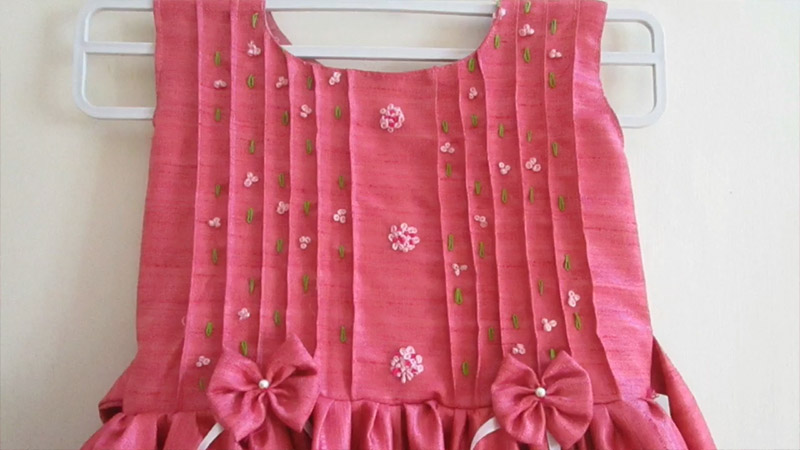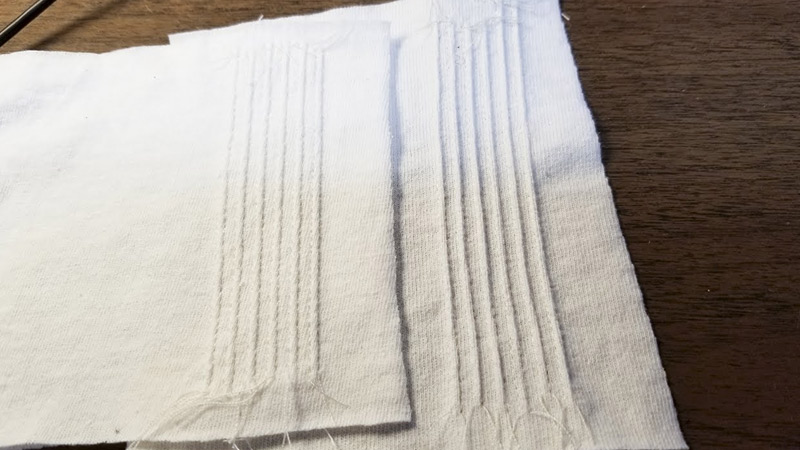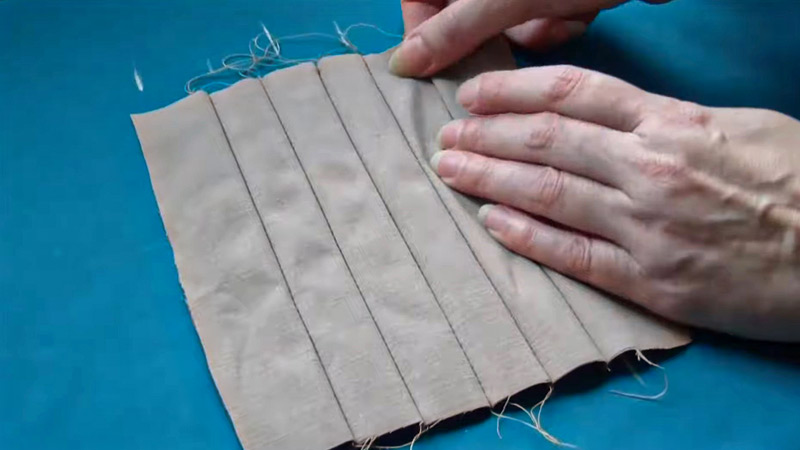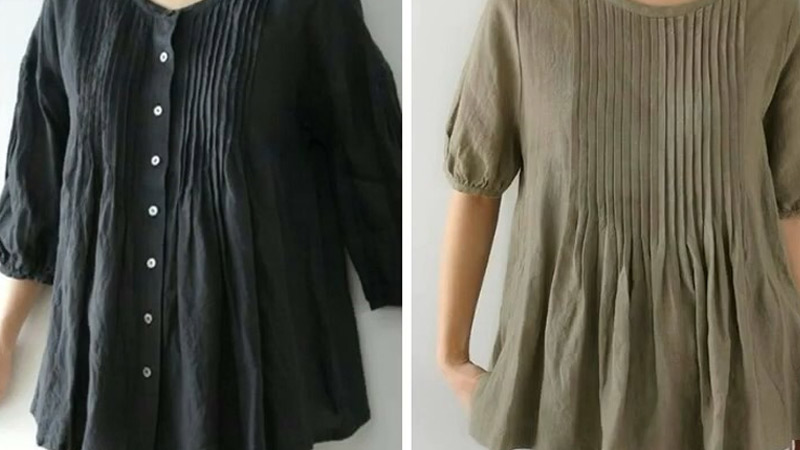In sewing, the term “pin tuck” sounds small, but its impact on fabric is anything but. Pin tucks are a meticulous and artistic technique used to create tiny, evenly spaced, and decorative folds or pleats in fabric.
This exquisite detail adds depth, texture, and an element of sophistication to various sewing projects. Achieved by folding the fabric along marked lines and stitching it in place, pin tucks require precision and attention to detail.
From enhancing the elegance of clothing to elevating the aesthetics of home decor, pin tucks are a versatile and captivating embellishment that sewers often employ to infuse their creations with a touch of timeless charm.

What Is Pin Tuck In Sewing? -The Definition
Pin tuck in sewing is a popular sewing technique that refers to a decorative technique used to create delicate, evenly spaced folds or pleats in fabric, typically used to add decorative texture and dimension to clothing and home decor items.
These tiny tucks are created by folding the fabric and stitching it in place, producing a series of parallel raised lines that can run vertically, horizontally, or even diagonally.
Pin tucks are commonly seen on blouses, dresses, pillowcases, and table linens, enhancing the overall aesthetics of the piece.
To create pin tucks, you’ll need a few essential tools, including a sewing machine, pins, a ruler or spacing guide, and a fabric marker.
The process typically involves folding the fabric along marked lines, securing it with pins, and then sewing along the folds. Pin tucks can be made in various widths and depths, allowing for customization according to your design vision.
Types of Pin Tucks
Pin tucks are a versatile sewing technique, and there are several types to explore, each offering unique textures and visual effects.
Here are some common types of pin tucks:
Single Pin Tucks
Single pin tucks involve folding a single layer of fabric and stitching it down along the fold. These tucks are usually small and close together, creating a delicate and understated texture.
They are often used for embellishing cuffs, collars, and bodices in garments like blouses and dresses.
Double Pin Tucks

Double pin tucks are formed by folding the fabric twice and then stitching it in place. This results in two parallel tucks, adding more dimension and depth compared to single pin tucks. Double pin tucks are frequently seen on formal attire and heirloom sewing.
Parallel Pin Tucks
These tucks consist of evenly spaced lines running parallel to each other across the fabric. They can be single or double, depending on the desired effect.
Parallel pin tucks are a timeless choice for adding a touch of sophistication to various sewing projects, including table linens and children’s clothing.
Diamond Pin Tucks
To create diamond pin tucks, you stitch a series of diagonal lines in a crisscross pattern. This technique adds a sense of movement and visual interest to the fabric, making it suitable for creating unique, eye-catching designs on skirts, blouses, and accessories.
Curved Pin Tucks
Curved pin tucks follow gentle curves or waves, giving the fabric a fluid and organic appearance. This style is often employed to add a romantic and feminine touch to garments like wedding dresses, nightgowns, and lingerie.
Shadow Pin Tucks
Unlike traditional pin tucks, shadow pin tucks are created on the right side of the fabric, typically using a thicker thread or decorative thread.
This technique results in a subtle shadow or contrast effect, enhancing the fabric’s overall texture and appeal. It’s a popular choice for eveningwear and high-fashion garments.
Smocking
Although not technically pin tucks, smocking involves gathering fabric into small, decorative stitches to create a textured surface.
This technique is commonly used in children’s clothing, particularly on the bodices of dresses, and can be seen in vintage-style garments.
Cross-stitched Pin Tucks
These pin tucks are secured at their intersections with small cross-stitches, adding both visual interest and extra stability to the fabric. This style is often employed in heirloom sewing and delicate, finely detailed projects.
What Are Pin Tucks Used For?

Pin tucks are a versatile sewing technique that can be used for various purposes in garment and fabric design.
Here are some common applications of pin tucks:
Decorative Embellishments
When used for decorative purposes, pin tucks are akin to fine embroidery or delicate lacework. They can be precisely spaced to create intricate geometric patterns or be more loosely distributed to impart a subtle, textured elegance.
Whether as vertical accents on a button-up shirt or as horizontal embellishments on a formal gown, pin tucks enhance the visual appeal of garments, making them stand out in terms of texture and design.
Cuffs and Collars
Pin tucks on cuffs and collars add a touch of refinement to shirts and blouses. They provide a subtle contrast to the rest of the garment and give it a tailored appearance.
For instance, pin tucks on the cuffs of a women’s blouse can transform a simple piece into a stylish and sophisticated fashion statement, perfect for both casual and formal occasions.
Bodices
Placing pin tucks on the bodice of a dress or blouse allows for creative design opportunities. They can be arranged in various ways, such as in diagonal lines, chevron patterns, or cascading formations.
These designs can enhance the wearer’s silhouette, drawing attention to the chest area and creating a flattering visual effect. In bridal wear, pin tucks are often used to craft intricate and timeless bodice designs.
Skirts
Pin tucks on skirts can add grace and fluidity, particularly when used on bias-cut fabric. When arranged horizontally, they create a sense of movement as they follow the curve of the hips and thighs.
Creative placement and patterning of pin tucks on skirts can take a simple garment to a whole new level of elegance and style, making it a versatile choice for both casual and formal occasions.
Children’s Clothing

In children’s fashion, pin tucks are cherished for their ability to infuse garments with an air of nostalgia and sweetness.
They are often used on dresses, rompers, and christening gowns to create an enchanting and timeless look.
Pin tucks on children’s clothing projects a sense of care and craftsmanship, making them ideal for special occasions and cherished keepsakes.
Lingerie
Pin tucks lend an air of delicacy and sophistication to lingerie. When used on nightgowns and camisoles, they create a romantic and feminine allure.
These fine, evenly spaced folds add to the overall elegance and luxury of intimate apparel, making the wearer feel both comfortable and alluring.
Home Decor
In the realm of home decor, pin tucks can transform everyday items into elegant and refined pieces. Tablecloths, for example, can be adorned with pin tucks to add a touch of opulence to a formal dining setting.
Curtains with pin tucks exude an air of timeless charm, while pillowcases become decorative accents that elevate the look of any room. Pin tucks are versatile in home decor, allowing for customization to match a variety of interior styles.
Heirloom Sewing
Pin tucks are an essential technique in heirloom sewing, where craftsmanship and tradition take center stage.
In this context, pin tucks are often used to create intricate and timeless designs on special occasion garments. Wedding dresses, christening gowns, and heirloom quilts are elevated by the fine detailing of pin tucks.
These creations are not only beautiful but also hold sentimental value, passed down through generations as cherished family heirlooms.
Textured Fabrics
Pin tucks are a valuable tool for textile artists and fabric designers looking to manipulate fabric textures.
By varying the spacing and width of pin tucks, artists can create visually captivating textures that go beyond the conventional flat surface.
This makes pin tucks a critical element in artistic and experimental textile art, where fabric becomes a medium for self-expression and creativity.
Vintage and Retro Styles
The charm of vintage and retro styles owes much to the use of pin tucks. Whether it’s 1950s-inspired circle skirts, 1920s flapper dresses, or Victorian-era blouses, pin tucks are employed to recreate the elegance and sophistication of bygone eras.
They play a pivotal role in capturing the essence of historical fashion trends, allowing modern fashion to pay homage to the past while remaining relevant in the present.
Quilting
In the world of quilting, pin tucks can serve as an exquisite decorative element. When incorporated into quilted projects, pin tucks add a three-dimensional quality to the design.
By strategically placing them amidst quilt blocks or along the borders, quilters can achieve a textured effect that brings depth and visual interest to their creations.
Whether in traditional patchwork quilts or contemporary art quilts, pin tucks offer a versatile tool for elevating the aesthetics of quilting projects.
Accessories
The versatility of pin tucks extends to accessories as well. Scarves, handbags, and hats can all benefit from the addition of pin tucks. When used on scarves, they create a luxurious texture that drapes elegantly around the neck.
On handbags, pin tucks provide an extra layer of style and sophistication, making the accessory stand out. Pin tucks can even transform a plain hat into a fashion statement, adding a unique and stylish touch.
15 Types of Tucks in Garments
Tucks in garments are folds or pleats created in the fabric to achieve various design effects and functional purposes.
Here are 15 common types of tucks used in garments:
Box Pleats
Box pleats are characterized by their wider and symmetrical appearance. These pleats create a neat, folded square or rectangular shape in the fabric.
They are often employed in garments like skirts, pants, and sleeves where both ease of movement and a tailored appearance are desired.
The symmetrical nature of box pleats ensures that they maintain a uniform and structured look.
Knife Pleats
Knife pleats are sharp, narrow folds that lay flat in one direction, resembling the edge of a knife blade. These pleats are commonly associated with school uniforms, kilts, and certain styles of skirts.
They offer a classic and clean aesthetic, often used to create a uniform appearance in institutional or formal attire.
Accordion Pleats
Accordion pleats consist of tight and continuous vertical folds that run parallel to each other. When the fabric is stretched or extended, accordion pleats expand, creating a sense of flair and movement.
Conversely, when the fabric is relaxed or allowed to drape naturally, the pleats collapse neatly. These pleats are favored in garments like skirts, dresses, and blouses, adding both visual interest and a dynamic quality to the design.
Inverted Pleats
Inverted pleats are created by folding the fabric inwards towards the center of the garment, concealing the fold.
This design choice imparts a sleek and sophisticated appearance, often found in various clothing items, including skirts and dresses.
Inverted pleats provide a polished and streamlined look, making them suitable for both casual and formal attire.
Kick Pleats
Typically located at the back of skirts or dresses, kick pleats serve the dual purpose of allowing ease of movement while maintaining a refined appearance.
When the wearer walks or sits, the pleat slightly opens, resembling a small triangular fold. Kick pleats are a practical choice for skirts and dresses, ensuring comfort without compromising on style.
Box-Pleat Back
This design element features a box pleat running vertically down the center back of a shirt or blouse. It serves a practical purpose by allowing extra room and comfort in the garment, particularly in the shoulder and upper back area.
Despite its functional aspect, the box-pleat back maintains a tailored appearance, ensuring that the shirt or blouse retains its structured and polished look.
Sunburst Pleats
Sunburst pleats are a visually striking variation of pleats that radiate outward from a central point, creating a dynamic and dramatic effect.
These pleats are often used in skirts and dresses to add flair and movement to the design. Sunburst pleats can resemble the rays of the sun, creating an eye-catching and energetic appearance that adds a touch of excitement to the garment.
Gathered Tucks
In contrast to traditional pleats, gathered tucks involve drawing the fabric together to create a gathered or ruched effect. This technique is often employed in waistbands, cuffs, and neckline detailing.
Gathered tucks provide a sense of fullness and texture, lending a soft and romantic aesthetic to the garment.
Release Tucks
Release tucks are an interesting variation where a portion of the tuck is stitched down, and then the fabric is released below the stitching line.
This allows the fabric to flare out or “release” below the tuck, creating a decorative and flowing effect. Release tucks are commonly used for adding movement and visual interest to skirts, dresses, and other garments.
Faux Tucks
Faux tucks are simulated tucks that mimic the appearance of actual tucks without the need for folded fabric.
They are created through techniques like topstitching or fabric manipulation, giving the illusion of tucks on the surface of the fabric.
Faux tucks are often used for decorative purposes, offering a simplified way to achieve the look of tucks without the labor-intensive folding and stitching.
Beaded Tucks
Beaded tucks are a luxurious variation of tucks that incorporate beads or other embellishments along the tucks for added decorative appeal. These beads can be sequins, pearls, crystals, or other decorative elements.
Beaded tucks are often found on evening gowns and special occasion attire, where they contribute to the garment’s elegance and opulence, catching the light and creating a stunning visual effect.
Hem Tucks
Hem tucks are small, narrow folds or pleats placed near the hemline of a garment. They serve a dual purpose by adding a subtle decorative element to the bottom edge of the garment while also providing a slight flaring effect.
Hem tucks can be used in skirts, dresses, and blouses to create a delicate and stylish finish to the garment’s hem.
Shoulder Tucks
Shoulder tucks are strategically placed folds or pleats around the shoulder area of a garment, typically on blouses, tops, or dresses.
These tucks create a gentle gathering or draping effect, adding interest and detail to the upper part of the garment.
Shoulder tucks not only enhance the aesthetics of the garment but also provide ease of movement in the shoulder area, making them a practical and stylish choice.
Cross Tucks
Cross tucks are diagonal folds or pleats that intersect at a point on the fabric, creating a dynamic and visually appealing pattern.
These tucks are often used as a decorative element in blouses, skirts, and dresses, adding interest and texture to the design. Cross tucks can be arranged in various patterns, creating a unique and eye-catching look.
Yoke Tucks
Yoke tucks involve creating folds or pleats near the yoke of a garment, typically found in shirts, dresses, and tops. Yoke tucks provide a tailored appearance while allowing for ease of movement in the upper body.
They are commonly used in Western-style shirts and some casual dresses, contributing to the garment’s overall style and functionality.
Difference Between Tuck and Pin Tuck
Tucks and pin tucks are both sewing techniques used to create folds or pleats in fabric, but they differ in several key ways.
Here are the differences:
Method of Folding
- Tuck: Tucks are created by folding a section of fabric and then stitching it down along the fold. This fold can be simple or more complex, depending on the desired design.
- Pin Tuck: Pin tucks are a specific type of tuck that involves folding a single layer of fabric and stitching it down along the fold. Pin tucks are typically small and closely spaced.
Size and Spacing
- Tuck: Tucks can vary widely in size and spacing. They can be large or small, and the distance between tucks can also vary, depending on the design intent.
- Pin Tuck: Pin tucks are usually small and closely spaced, creating a delicate and understated texture. They are consistently narrow and evenly spaced.
Appearance
- Tuck: Tucks can have a broader and more prominent appearance, making them suitable for creating bold design elements or adding volume to the fabric.
- Pin Tuck: Pin tucks have a finer and more refined appearance. They are often used for creating subtle texture and embellishments.
Usage
- Tuck: Tucks are versatile and can be used for various design purposes, from adding volume to garments to creating decorative elements.
- Pin Tuck: Pin tucks are primarily used for decorative purposes. They are commonly seen on blouses, dresses, and children’s clothing to create a textured and elegant look.
Complexity
- Tuck: Tucks can be simple or complex, allowing for more creative freedom in design. They can be combined with other sewing techniques and used in various ways.
- Pin Tuck: Pin tucks are relatively simple and straightforward. They involve folding and stitching a single layer of fabric, making them easier to execute compared to some types of tucks.
FAQS
Can I Create Pin Tucks Without a Special Foot?
Yes, you can create pin tucks without a special pin tuck foot.
What Types of Fabric Are Suitable for Pin Tucks?
Light to medium-weight fabrics such as cotton, silk, and linen are ideal for pin tucks.
How Can I Achieve Different Widths of Pin Tucks?
To create pin tucks of different widths, you can adjust the spacing between the tucks and the distance from the fabric edge.
Are Pin Tucks Only for Clothing?
No, pin tucks can be used in various sewing projects beyond clothing.
Can I Use Contrasting Thread for Pin Tucks?
Yes, using contrasting thread for your pin tucks can create a visually striking effect.
To Recap
Pin tucks in sewing are a timeless and versatile technique that adds elegance, texture, and dimension to a wide range of projects.
Whether used for their decorative charm on clothing or to enhance the aesthetics of home decor items, pin tucks offer endless opportunities for creative expression.
From delicate and closely spaced pin tucks to bolder and broader tucks, the variations in style and spacing allow for customization and personalization.
With their ability to evoke nostalgia, enhance sophistication, or infuse a touch of opulence, pintucks continue to be a beloved and enduring detail in the world of sewing, elevating the artistry of craftsmanship and design.
Leave a Reply